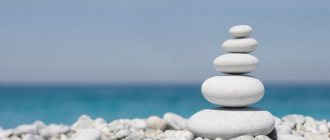Relaxation is a conscious reduction in muscle tone. Relaxation can be achieved through the use of special techniques, exercises or medications. The goal of relaxation in any of the techniques is to achieve complete relaxation of the body, thanks to which an increase in performance and a decrease in mental and physical stress is achieved, which has a positive effect on the psyche.
Relaxation techniques are quite popular in yoga, psychotherapy, hypnosis and various health systems. Relaxation techniques are considered to be a method akin to meditation, which are both effective ways to combat stress.
Various relaxation methods are especially effective for people who have increased muscle tone, since it is the cause of many diseases. People with decreased muscle tone experience less of the relaxation effect. When a stress factor affects a person, muscle tension is created in the body. This tension is a defensive reaction, preparing the body for action. The body receives a danger signal - stress, and turns on active defense.
Stress has come a long way of evolution, from the fear of a creeping tiger to the modern stress of people - problems with writing a diploma, civil strife with superiors. Such stressors require long and intense thinking. It turns out that the muscle tone remained as strong as before, because there was no discharge, but on the contrary, everything had accumulated inside and put pressure on the person.
Chronic stress, small or insignificant, becomes an obstacle to the spontaneous release of muscle tension and the muscle clamps formed by it. Muscle tension absorbs a large amount of energy, interferes with good blood flow, makes attention scattered and the state tense.
Many people know about the relaxation method, that it is a very useful way of restoring strength, which gives an invaluable effect, it does not require material investments and is quite affordable for every person. Despite daily stress, a person can protect himself from their negative impact in this way.
The effectiveness of systematic relaxation sessions is recognized by modern psychotherapists. According to the theory of the positive impact of relaxation on a person’s mental state, there is a specific strong connection between the mind and body and a person needs to maintain it. An important point in psychotherapy using relaxation techniques is generalization. Generalization is the spread and consolidation of the effect. If you do not do it systematically and superficially, then the effect will be just as temporary and of poor quality. Through regular, persistent practice, you can achieve generalization and long-term positive effects of relaxation on the individual.
What is relaxation really?
Relaxation is the complete release of psychological and muscular tension in order to restore strength. Reducing skeletal muscle tone is achieved through the use of special medications, physiotherapy or psychophysiological techniques.
Which contributes to a positive physical state: oxygen saturation of the blood, pain relief, a feeling of increased strength, and normalization of sleep. And also emotional: overcoming depression, mental illness. And this is only an incomplete list of all the positive aspects of relaxation.
In psychology, the relaxation period is the beginning of treatment, the primary procedure before the actual help. Already now you can become familiar with the basic principles and practical techniques and thereby raise your life potential to a new, better level. Various types of relaxation will help you relax properly and feel ready for new victories.
Advantages of relocation for an employer
Personnel shortage is the main reason for the transfer of employees from one department to another. But relocation has other advantages that are successfully used by leading corporations.
A fresh look at new territories helps broaden the horizons and develop the creative potential of managers. Sending experienced employees to the regions leads to the growth of local corporate culture and the improvement of business processes in general.
Employees who agreed to move are focused on their tasks and work. The labor efficiency of these specialists increases, and the company receives greater returns from them than with routine work.
Another advantage of relocation is testing the potential of promising employees. Successful activities in a new place can become a launching pad for career growth.
Types of body calming: how to relax correctly
Currently, the rapid pace and rhythm of life in all areas and spheres forces you to adapt and correspond to its flow, which in itself does not allow you to relax. Sail through the stormy waves, falling into the whirlpools of everyday stress, emotional and physical tension. Often, without finding time for stops and breaks, drawing out the maximum available resources of energy and strength, you can encounter negative consequences associated with stress, deterioration of health and other factors.
Already now you can take a minute, get acquainted and discover special techniques and relaxation techniques that will help increase your performance in the intense rhythm of life and at the same time relieve tension in the nervous system. Thereby preventing and eliminating the possibility of encountering unpleasant situations.
Achieving emotional peace through partial or general relaxation is not necessarily possible at a certain time in a certain place. Performing techniques “on the go” will help you avoid stressful situations, feel a surge of new strength and cheer up.
Depending on the duration, relaxation can be:
- long-term (sleep);
- short-term (occurs immediately after tension).
It is worth noting that long-term rest is the best way to help restore the body. According to the type of occurrence of relaxation, they are classified into:
- artificial (consciously caused);
- natural (comes after physical activity).
Natural relaxation should occur naturally; try to turn off your mind so as not to interfere with your desire to relax.
By depth of influence:
- external (short-term 3-5 minutes);
- internal (artificially worked out in detail for 25-30 minutes).
Motivational expectations of employees during relocation
For most employees, making the decision to move is a very difficult decision. Social connections are collapsing, everyday issues have to be resolved, and uncertainty is frightening. Changing your place of residence is a real stress, so relocation requires a serious incentive.
According to surveys conducted among middle managers and managers without subordinates, many respondents believe that it is easier to change jobs than to move. Those employees who agree to move have high and sometimes inadequate requirements for the relocation package, and employers cannot satisfy their wishes.
What determines an applicant’s positive response to a transfer and what offers do employees expect from employers?
Salary increase
Monetary incentive is the main motivating factor for most people. Employees are reluctant to move if they are offered a similar position with a comparable compensation package. Typically, to agree to move, a 30-50% increase in payment is required.
In some cases, workers expect an increase in earnings by 50-70%, and sometimes a double increase. An increase in wages is justified when candidates move to large cities from the provinces. Higher living costs in metropolitan areas require higher incomes.
Often the relocation package includes the payment of 1-2 salaries upon transfer. This is compensation for the costs of initial setup and relocation.
New job location
An employee’s desire to transfer to another territory directly depends on the location of the new workplace. Moscow and St. Petersburg, large regional centers, are the most attractive.
When transferring jobs to capitals from the regions, employers rarely encounter resistance. According to surveys, about 70% of residents agree to move to Moscow. Russian citizens also consider the southern regions of the country attractive due to their warm climate.
Traditionally, young people are interested in working abroad. Foreign experience helps to improve your language skills and familiarize yourself with new technologies. Citizens of the CIS often go to Russia to work. The reason lies in the lack of jobs in these countries.
Career
Typically, employees are reluctant to move unless the new job offers a promotion. Exceptions are Moscow and St. Petersburg. Employees expect vertical or at least horizontal growth from their employer when moving. A temporary transfer may include promotion upon return.
Almost all enterprises bear the costs associated with personnel relocation, so it makes sense to transfer employees who have proven their effectiveness at the enterprise and have reached certain career heights.
An employee’s consent to move indicates loyalty to the employer and has a positive effect on his position in the company, and the accumulated experience increases professional value.
Relaxation: what is it - 5 methods of complete and partial relaxation
Relaxation methods and techniques are practiced on the main 5 main principles. Namely:
- music;
- breathing exercises;
- visualization.
- types of meditations;
- deep meditation;
You can read separately about the technique that is based on music later in this article. Breathing exercises (pranayama) are based on full awareness of the process of inhalation and exhalation. On detailed attention to rhythm, feeling, warmth, the sounds of the movement of the diaphragm.
Visualization exercises are based on imagining a positively colored image or a certain situation, where creating a picture in your head brings pleasant sensations. Perhaps these will be memories of moments from life, relaxation, beautiful nature or tropical beaches.
You can also use your vivid imagination and draw your own world in your mind: let it be just your island of peace and quiet. By creating this reality, you transfer yourself into it in detail and detail, imagining not only the image, but smells, tastes, touches.
Visualizing yourself anywhere is an endless expanse of your imagination that will quickly take you to any place on earth (or beyond), allowing you to relax, elevate your spirit and develop creative thinking. And don’t forget that ideas and thoughts materialize. But this is a different method of relaxation through meditation.
Among the variety of meditations, you can choose the one you like or practice several. Meta meditation, Vipassana, Kundalini, Zazen and other Buddhist practices are highly developed and historically established, and are effectively used all over the world. For example, Vipassana originated in the 6th century BC.
The main principle remains the same - to move into another state of consciousness, achieving a certain level of relaxation of the mind and body. Disconnecting from external stimuli and transferring consciousness to another dimension invented by you.
The transition to deep meditation is characterized by a slowdown in brain activity, which allows the body to relax, making it weightless. In this state, some “dissolve”, others “get heavier”, many feel a slight warm or, conversely, cold breath in the head or arms and legs.
With a deeper immersion in relaxation, these sensations come more clearly, brighter and more often, replacing beta rhythms with alpha rhythms. The latter waves are characteristic of the brain in complete relaxation or sleep mode. The deeper the meditation, the more effective the body's restorative reactions to relaxation.
When starting to study and practice these methods, you need to follow important rules, remembering that effort and mastery of the techniques will allow you to easily and effectively help not only the body, but also the mind. So, daily classes for the first month should last 20-30 minutes with a frequency of 3-4 times a day, finding time in the morning, afternoon and evening.
The frequency of subsequent practices is reduced to two to three times every seven days. Focused activities should begin in a calm and comfortable place, with relaxing music or sounds turned on.
relax is... What is relax?
- relax - relax ... Dictionnaire des rimes
- relax - [rəlaks] adj. et n. VAR. relax, ax • v. 1955; de l angl. to relax «se détendre» ♦ English. fam. 1 ♦ (Choses) Qui favorise la détente, un repos détendu. Une soirée très relax. Appos. Fauteuil relax, ou nm un relax : fauteuil ou chaise… … Encyclopédie Universelle
- Relax — Relax, Take It Easy Saltar a navegación, búsqueda Relax, Take It Easy (Relájate, tómalo con calma) es un sencillo de 2006 de Mika, de su álbum debut Life in Cartoon Motion. En el Reino Unido, no llegó a las listas la primera versión del vinilo de … Wikipedia Español
- RELAX NG - (REgular LAnguage for XML Next Generation) is one of the languages for describing the structure of an XML document. While itself an XML document, a schema in this format can be written using an alternative, more compact syntax[1]. In... ... Wikipedia
- RELAX NG - (REgular LAnguage for XML Next Generation) est un langage de description de document XML issu de la fusion de TreX de James Clark et de Relax de Murata Makoto. Considéré comme une alternative préférable à XML Schema, c est un dialecte XML… … Wikipédia en Français
- Relax NG - (REgular LAnguage for XML Next Generation) est un langage de description de document XML issu de la fusion de TreX de James Clark et de Relax de Murata Makoto. Considéré comme une alternative à XML Schema, c est un dialecte XML permettant de… … Wikipédia en Français
- Relax — may refer to:* Relax (song) by Frankie Goes to Hollywood * Relax, Take It Easy , a 2006 song by Mika * Relax (film), a Tamil film * Relax…It s Just Sex , a 1998 film * RELAX , short for Regular Language description for XML, a specification for... ... Wikipedia
- Relax - Re*lax (r? l?ks), vt [imp. &pp {Relaxed} ( l?kst ); p. pr. &vb. n. {Relaxing}.] [L. relaxare; pref. re re + laxare to loose, to slacken, from laxus loose. See {Lax}, and cf. {Relay}, n., {Release}.] 1. To make lax or loose; to make less… …The Collaborative International Dictionary of English
- relax — re‧lax [rɪˈlæks] verb relax rules/laws/restrictions etc to make rules etc less strict: • The country decided to relax its rules on the foreign ownership of its airlines. • Many employers are taking steps toward relaxed dress codes (= being… … Financial and business terms
- Relax - (Offenbach, Germany) Hotel category: Address: Karlstr. 62, 63065 Offenbach, Germany … Hotel directory
- relax - vt. [ME relax, to loosen
Source: https://dic.academic.ru/dic.nsf/fre_rus/60723/relax
Relaxation exercises for preschoolers
Modern children, no less than their parents, are today burdened with various clubs, extracurricular activities, kindergarten, physically and emotionally. Just like in adults, the negative impact of stress can have a negative impact on the emotional and physical state of the child.
Children's nervous systems are imperfect, which can cause poor sleep, capricious behavior or overexcitement. You can learn to be more attentive, calm and balanced with the help of children's relaxation practices.
In a playful way, using certain techniques, you can teach your child breathing techniques. As well as others designed to relax the muscles of the face, neck, arms and the whole body. It is not only fun, but also useful for both children and parents.
Having fully understood and mastered relaxation techniques, you can feel cheerful and calm without leaving home or your workplace, avoid stressful situations and give your body a break, setting up its complex system for the next charged up mood.
Why is relaxation needed?
To restore the physical strength of the body, there is sleep and rest; signs of emotional exhaustion arising from unfavorable external conditions and stressful situations can be eliminated by muscle relaxation. There are many techniques aimed at relaxing the body. All of them create a feeling of heaviness, warmth, and immerse a person in a state of peace. As a result, signs of overwork are relieved, performance increases, and mood improves. Musical accompaniment - sounds of nature, calm melodies make relaxation effective.
Massage therapist tips for relaxing the body
Relaxation, as an integral part of a successful and fulfilling life, plays an important role in the hustle and bustle and the huge flow of negative influences on a person. “The effect of massage is the power of life” in the words of Hippocrates.
With the help of a massage, you can not only achieve complete relaxation, but also calm the nervous system, enrich the blood with oxygen, which will force you to reboot the “brain”. Feel the tone and surge of strength throughout the entire body, as well as an important psychological component - feel the warmth of human hands. Tactile contact also has a positive effect in cases of prolonged depression.
One of the techniques for relaxing the body is massage. Numerous techniques and directions will help you achieve positive results in relaxation. Massage affects on three levels: bodily, nervous system, emotional. The Anti-stress program, for example, will relieve overstrain. An ordinary classic relaxing general massage has no contraindications and is easy to perform.
Relaxing massage and techniques for performing it
Immerse yourself in an atmosphere of calm and tranquility, mentally detaching yourself from the everyday hustle and bustle and routine, using special massage techniques that are available to everyone. They will give relaxation to the body, emotionally refresh, relieve fatigue, anxiety, anxiety and help to escape. A relaxing classic massage includes light, pleasant movements.
- stroking,
- trituration,
- kneading,
- pat,
- vibration.
The main emphasis is on the back, then the neck, limbs, head, face. Moreover, the direction of movement must strictly coincide with the direction of venous blood, driving it through the vessels. You can add the effect of aromatherapy to the massage procedure itself by using candles and sticks with pleasant aromas. The music will also create an appropriately relaxing atmosphere for maximum effect. Traditional and non-traditional, they will be a wonderful alternative or addition to other relaxation practices.
How to forcefully relax in 1 minute
Anxiety and stress, as a protective reaction of the body, overload our system, forcing it to work to the limit, and ultimately the person gets sick or experiences depression. You can help yourself to relax under conditions of stress and tension without outside help, eliminating anxiety and panic in a minute, using an express course.
How to completely relax in 1 minute?
It is better to practice the technique for the first time at home in a familiar environment and in comfortable clothes. How to force yourself to come into harmony with yourself and relax in a minute:
- Find a quiet place.
- Turn off the music, creating complete silence.
- Think only about what you need to achieve complete relaxation, freeing them from other extraneous thoughts.
- Work on comparison and contrast. To feel relaxation, create tension. You should clench your hands tightly into fists for 10 seconds. Then place your hands loosely on your knees and feel the difference. Next we tense our forearms, bending our elbows and pressing our fists to our forearms.
- Back of the arms: Straighten your arms as much as possible.
- We raise our shoulders to our ears.
- Throw your head back.
- Raise your eyebrows as if asking.
- Close your eyes tightly.
- Clench your teeth tightly.
- Press your tongue on the roof of your mouth.
- Press your lips very tightly.
- Inhale deeply and hold your breath.
- Form abdominal press.
- Arch your back and squeeze your buttocks.
- Straighten your leg and bend your toes.
Each item will take 10 seconds. Practicing this technique will help you get to know your body better and further work on individual parts of the body that require relaxation.
TOP 5 methods and exercises for relaxation
Learning to relax psychologically and physically is very important in the modern world. In times of constant stress and anxious situations, it will be important to introduce relaxation techniques into your life. We present to your attention the top five simple and effective relaxation methods for studying and practicing them in everyday life.
First. A breathing exercise that helps in stressful situations, based on deep and even inhalation and exhalation. This will enrich the body with oxygen and make you feel much better. Inhale and exhale deeply and slowly, mentally counting to four. It is also an effective way to combat insomnia.
The second, often practiced exercise is concentrating full attention on your body: its parts, starting with the face and ending with the extremities of the feet. After inhaling and exhaling deeply but slowly several times, you need to direct your consciousness to certain muscles of the body. Try to feel them and relax them.
By taking your time slowly and carefully, paying attention to each muscle, you achieve complete relaxation, relieving tension. This easy exercise does not require a lot of time (15-20 minutes is enough), but it is advisable to perform it in a pleasant place with dim lights and quiet, relaxing music.
Many people perform it before bed, setting up and preparing the body for sleep, relieving daytime stress. Third. Another exercise in the top will be “Word”. It is especially suitable for those who find it difficult to visualize images. Mental work consists of repeating to yourself the description of the sensation and transmitting it to every part of the body, thereby achieving complete relaxation.
For example, slowly and calmly saying: “My right hand is relaxed...I feel a pleasant tingling sensation in my hand.” and so on, moving on to each part of the body, not forgetting the limbs and face. With the help of the “Word” you can feel warmth, tingling or heaviness on the physical level, which will confirm the correctness of the exercise. By doing this regularly, you can achieve a result in which only with the thought “I am relaxed,” you will feel complete relaxation of the whole body.
The next exercise is based on the laws of physiology, when after strong tension the body relaxes. The fourth exercise, based on muscle relaxation, was developed back in the last century by the American doctor Jacobson. According to the principle “after tension comes relaxation,” you need to strongly tense the muscles of the whole body, counting to 15, and during the next 15 seconds of relaxation, concentrate on this feeling. The exercise is done in several approaches with a break.
The fifth technique was developed by the American Jose Silva. It is based on knowledge about the levels of brain waves, measured in Hz. Thus, beta waves are characteristic of normal wakefulness, alpha waves - relaxation, theta waves - deep relaxation, delta waves - deep unconscious sleep. Entering the alpha state has the most beneficial effect on the brain, and the following exercise can contribute to this.
Find a comfortable position and take a few deep breaths before starting. Imagining and saying to ourselves each number, from three to one, we continue imagining 10 and say another phrase - “I’m relaxing”, 9- “I’m calming down”, 8- “I’m relaxing more and more”, 7- “I’m calming down more and more” stronger and stronger”, 6-“my mind is serene and clear”, 5-“my whole body is relaxed”, 4-“I am so relaxed that my body has become weightless”, 3-“I am completely calm”, 2-“I completely relaxed”, 1-“I am completely calm and relaxed.” “I’m in alpha” - quietly saying this phrase to yourself, you will feel the difference in your state.
By practicing relaxation skills from simple techniques to more complex ones, you will be able to resist any worries, anxieties and malfunctions of the body.
Relaxation as a path to achieving physical and mental health
Doctors and researchers have scientifically proven the benefits of rest, including targeted relaxation - relaxation. But it is also important not only to devote time to physical rest and relaxation using various techniques, resorting to effective massage, but also to be able to relax psychologically.
Relaxation relieves excess tension, removes worries, improves thinking and intuition. Relaxation brings conscious peace and relaxation of the body and mind.
Relaxation methods
Daily release for the body - relaxation can help you survive in difficult modern conditions. Deep relaxation techniques are aimed at working with your body and mind. The ability to control muscle tone, bring breathing into the desired rhythm, self-hypnosis - these techniques help to achieve a feeling of warmth and peace. Experts believe that the point on which relaxation of the entire body depends is the solar plexus. Other common ways to relax are:
- massage;
- bath;
- diaphragmatic breathing;
- swimming.
Relaxation techniques based on music
Music is an accessible and pleasant means of relaxation. Individually selected compositions allow you to set yourself in a relaxing mood and immerse yourself in a state of peace and tranquility. Today it will not be difficult to find soothing music for sleep, massage, spa treatments with various tracks and genres on the Internet, or by downloading special applications to your gadget.
Music of a moderate tempo and not overly emotional is ideal. Specially selected, it contains the necessary harmonies that affect the relaxer’s hearing. They also differ in the choice of instrument or performance style. Musical directions to completely relax:
- Turkish (ney) or Indian (sitar) are considered authentic, lulling and bewitching with oriental melodies.
- Jazz, which helps you better concentrate on your own feelings.
- Electronic music is ambient, without a clear rhythm.
- Trip hop with a distinct beat.
- Dream pop with its melancholic motives.
- Chill-out is a light and relaxing background.
- Guitar indie.
The sounds of a singing forest, raging sea waves, summer rain or others also help you feel safe and immersed in a relaxing journey. In this article we tried to answer the question: what is relaxation? Relaxation is a step towards self-knowledge, which qualitatively raises the standard of living to a new level.











